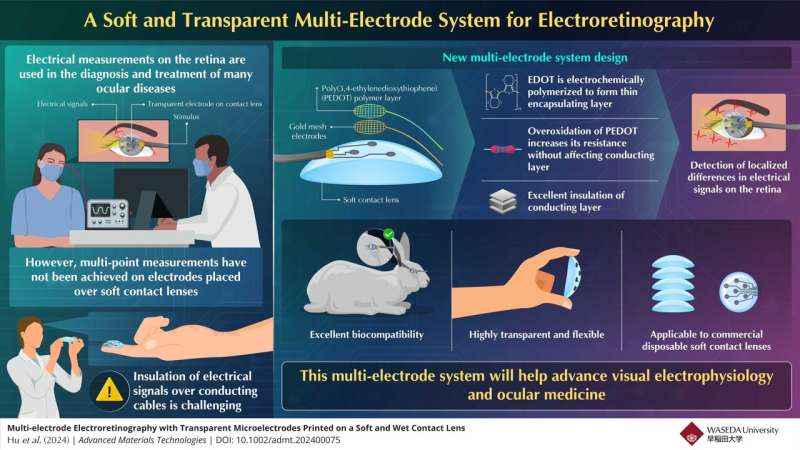This article has been reviewed according to Science X's editorial process and policies. Editors have highlighted the following attributes while ensuring the content's credibility:
fact-checked
peer-reviewed publication
trusted source
proofread
Research takes electroretinography to the next level with a soft multi-electrode system

Eye diseases are becoming more prevalent worldwide, partly because of the aging population, but also because of our greatly increased screen time compared to previous generations. Considering the use of displays will most likely keep rising due to technologies such as virtual and augmented reality, diagnostic techniques for the early detection and monitoring of ocular diseases should be improved.
Among the arsenal of tools ophthalmologist have at their disposal, electroretinography (ERG) still holds much-untapped potential. Simply put, ERG consists of taking measurements of the electrical potentials generated by neurons and other cells in the retina from the surface of the cornea. Many ocular diseases cause abnormalities in a person's ERG signals, including glaucoma, retinitis pigmentosa, and diabetic retinopathy.
Although many types of ERG measurement devices exist, few ERG electrodes can measure multiple localized ERG signals from different regions of the retina at the same time. In most cases, such measurements are performed using electrodes placed on hard contact lenses. This makes the procedure more complex, expensive, and particularly uncomfortable for the patient.
Against this background, a research team led by Professor Takeo Miyake from the Graduate School of Information, Production and Systems at Waseda University, Japan, set out to develop a new type of soft ERG multi-electrode system to overcome these issues. Their latest study, published in Advanced Materials Technologies, describes their findings. It was co-authored by Saman Azhari from the Graduate School of Information, Production and Systems at Waseda University, as well as Atsushige Ashimori and Kazuhiro Kimura from the Department of Ophthalmology at Yamaguchi University.
The proposed system utilizes a commercially available soft disposable contact lens. The researchers first immersed this contact lens in a solution containing the monomer 3,4-ethylenedioxythiophene (EDOT). They then placed carefully designed gold mesh electrodes with their respective connecting wires onto the inner surface of the contact lens. By circulating a current through the solution containing EDOT, the monomers formed an entangled polymer called PEDOT, which adhered well to the contact lens and fixated the gold components.
A key advantage of this approach is that the PEDOT layer can be overoxidized by using a DC voltage under dry condition, thereby forming a highly insulating layer on the collecting wire. This insulation is critical to ensure different retinal signals flowing through the gold wires do not interfere with one another or with signals originating from other regions of the eye.
By carefully designing the gold mesh of the electrodes to spread currents during overoxidation process, the PEDOT encapsulating the mesh region does not overoxidize, thus ensuring good electrical contact with the eye.
The result of this innovative process is a flexible and highly transparent multi-electrode system for ERG measurements that is just as comfortable as commercial disposable contact lenses. The researchers carefully examined the optoelectrical properties of their multi-electrodes and also conducted some experiments on rabbits, as Miyake comments, "Our device was used in animal experiments, confirming its biocompatibility and suggesting a correlation between the location of the electrodes and the intensity of the recorded ERG signals. In other words, our design could enable precise spatial measurements of multiple ERG signals simultaneously."
Taken together, the findings of this study would help us better understand and diagnose ocular diseases. "The use of augmented and virtual reality devices is growing quickly, and the precise and continuous monitoring of eye conditions will become a necessity," says Miyake.
"A smart contact lens such as the one developed in this work could be connected to a local network to transmit the eye's health condition to an ophthalmologist or health care specialist while the user is performing their daily routine. Such systems could prevent irreparable damage to the eyes."
More information: Lunjie Hu et al, Multi‐Electrode Electroretinography with Transparent Microelectrodes Printed on a Soft and Wet Contact Lens, Advanced Materials Technologies (2024). DOI: 10.1002/admt.202400075




















